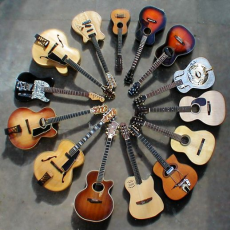
So far we’ve already discussed the standard guitar and bass guitar, but in this article we’re going to take a look at some variations in the guitar family, which are played in the same way (by the plucking of strings), but can produce a much wider variety of sounds. Because of this, they can be used in a much wider range of musical genres. Though the guitars of rock and pop bands are the ones that may immediately jump into our minds, each style of guitar is suited to specific styles of music and each has their own rich history.
Of course, there are various types of guitar and bass themselves anyway. Guitar has acoustic, electric, electroacoustic and classical varieties. In fact there are even more variations if you are an avid guitar player. For example, you can buy flamenco guitars which are specifically designed for Spanish flamenco music. However, these are much rarer than those types I mentioned to begin with and are only really useful if you want to become a professional in a certain style of guitar playing. Acoustic guitars and classical guitars are fairly similar, but differ in the material used for guitar strings. While acoustic tends to refer to those with steel strings, classical guitars tend to have nylon strings. Of course, until around the time of the Second World War, animal gut was used for making pretty much all guitar strings.
Electric guitars also have steel strings, but differ in the fact they tend to have a solid wood body, as opposed to a hollow body. It is for this reason that they require amplification using electrical signals, as the hollow body is what would usually give the guitar its volume, with the sound produced resonating inside. Pick-ups underneath the strings of the electric guitar record the sound produced and send it to the amplifier very quickly, so that we can hear it properly. Electro-acoustic guitars are a mixture between the two. The sound is created with steel strings, and can then be amplified using either of the two methods, naturally, there is some amplification from the hollow body, but this can be extended through pick-ups inside the guitar and an amplifier. This can also be used to create some sort of more typically electric tone, but in general is just used to increase the volume of the guitar.
Bass guitars also come in electric, acoustic and electro-acoustic varieties. They tend to require different amplification than standard guitars since they play notes in a much lower register. They would still be able to produce sounds on a normal amp, but over time, playing a lot of deep bass notes would ware out the speakers. Electric basses are far more common than acoustic ones, because it is much easier to get the levels of the different pitches equal sounding when it is possible to adjust the levels of each instrument. Acoustic basses have the potential to get lost under the much more obvious high tones ringing out. On the other hand, they can be a very useful practice tool, as they are much easier to play quietly and without disturbing anyone.
In my next article on guitar variations, I’m going to look at some further variants on the guitar we know and love, many of which are considered instruments in their own right, and discuss their roles in shaping musical style.
Image from: http://compcreation.com/Guitar%20Types/assets/dif_types.jpg

0 Comment:
Be the first one to comment on this article.